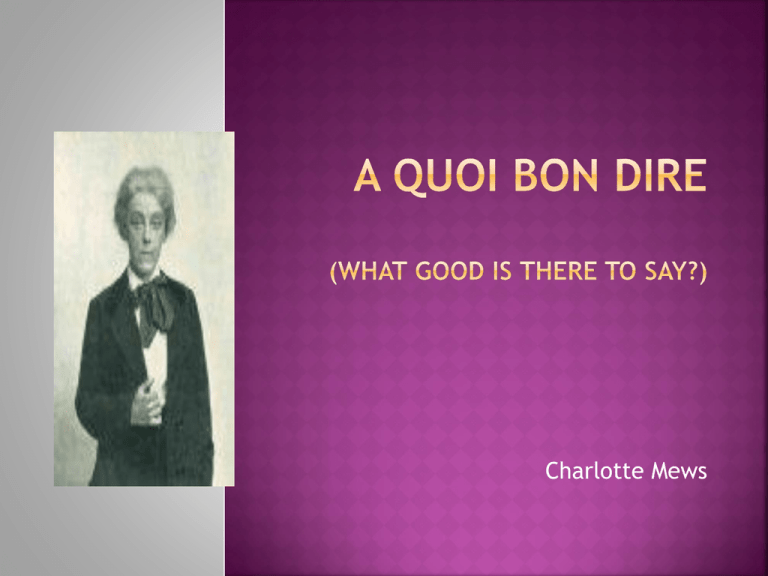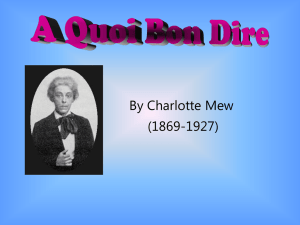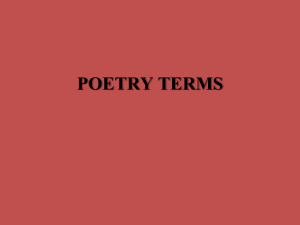A Quoi Bon Dire (What good is there to say?)
advertisement

Charlotte Mews Read the poem on you own. Write down your first responses to it: How does it make you feel? What do you think it is about? Charlotte Mew was born in London in 1869. Her first published work was a short story in The Yellow Book in 1894. In May 1912 Mew was introduced to May Sinclair, a leading novelist who was active in the women's suffrage movement. Mew fell in love with her, but although Sinclair encouraged her writing; she did not reciprocate Mew's feelings and the relationship eventually broke up. The period from 1913 was one of the most productive periods for Mew's poetry, however, and she became an increasingly published and admired poet. Living with her mother and sister Anne, an artist, in difficult circumstances, Mew found freedom and inspiration on holidays in France and Belgium. In 1923 she was awarded a Civil List pension on the recommendation of John Masefield, Walter de la Mare and Thomas Hardy. A fear of hereditary mental illness had led Mew and her sister to vow not to marry: both her elder brother and another younger sister had been taken to mental hospitals. In 1927, still grieving from the death of her sister, Mew killed herself, possibly because she feared the onset of insanity. Seventeen years ago you said Something that sounded like Good-bye: And everybody thinks you are dead But I. So I as I grow stiff and cold To this and that say Good-bye too; And everybody sees that I am old But you. And one fine morning in a sunny lane Some boy and girl will meet and kiss and swear That nobody can love their way again While over there You will have smiled, and I shall have tossed your hair. In this gentle poem of loss and ageing, Mew compares the idealistic optimism of youth with the realities of age and mortality. There is, though, no bitterness in the poem’s vision – the final images are carefree, although separated from the ‘fine morning in a sunny lane’ inhabited by the young lovers. Consider the effects of the way the first two stanzas isolate the speaker and the lost loved one before they are brought together in the longer third stanza. Note that the speaker addresses the loved one throughout the poem, implying that although separated ‘Seventeen years ago’, the relationship still exists. FORM/STRUCTURE How can each stanza be summed up? Who is each one about? Which lines particularly stand out and why has this been done? Why has the same structure been used for stanza 1 and 2? LANGUAGE Why is “Good-bye” capitalised each time? What do you understand by “stiff and cold” and “this and that”? Any techniques used here as well? How is language used in the final stanza to show a change in mood? Analyse the second line of stanza 3. Are any sounds predominant in this poem? What, where and why? RHYTHM/RHYME What do you notice about the rhythms of stanzas 1 and 2? Why does Mew do this? What rhyme scheme is used and why? Can you find any internal rhymes? Why are they used in this place? TONE How does the tone change throughout the poem? Which words highlight this? What is the mood by the end? Here the premise of the poem is made clear, it is written in the first person from the perspective of a person whose partner died seventeen years ago. However, although everybody else sees them as dead, in the speaker’s eyes they are still alive and present. Their love has transcended death itself and the speaker is addressing the dead lover throughout the poem. The sibilance in the stanza creates a slow pace and a calm, somewhat sorrowful tone. The rhyme scheme of ABAB gives it a measured pace. The steady rhythm in the first 3 lines of stanzas one and two is iambic tetrameter (or four iambic feet) followed by an abrupt 2 syllable line in lines 4 and 8. This rather short sharp end to the stanzas, emphasises how the lovers are contrasted with everybody else, and makes their love seem more powerful. More information is given in this stanza ‘stiff and cold’ is something of an idiom revealing that the speaker is on the verge of death. ‘This and that’ is an example of alliteration referring to life; the fact that it seems such a casual phrase denotes how little life means to them, compared to his or her lost love. Good-bye is capitalised, showing that it is the final good-bye, the farewell of death. Structurally, the first two stanzas are mirror images of each other. This parallel structure ties the two stanzas together, also connecting the speaker to the object of their affection. In the final stanza the lovers, previously separated, are reunited in death. The use of positive diction in the stanza ‘One fine morning in a sunny lane’ marks a change in tone; showing the speaker’s joy at finally becoming reunited with her lover. ‘Some boy and girl’ implies that everyone can feel as the two lovers do. The listing of’ meet and kiss and swear’ also makes the poem have universal relevance, it makes love seem easy and commonplace. There is also consonance with the repetition of the ‘l’ sound throughout this stanza. This creates a soothing tone, like a lullaby which reflects the mood. ‘While over there’ seems to imply that in death the lovers have reunited and are watching over a young couple in spirit. The final line shows the lover’s happily reunited and the poem ends on a positive note. The title ‘A Quoi Bon Dire’ means ‘What good is there to say’ – what is the relevance of the title?











